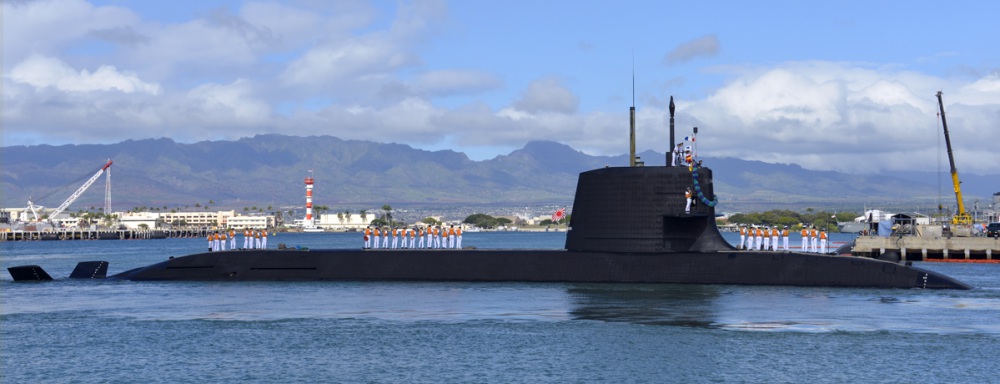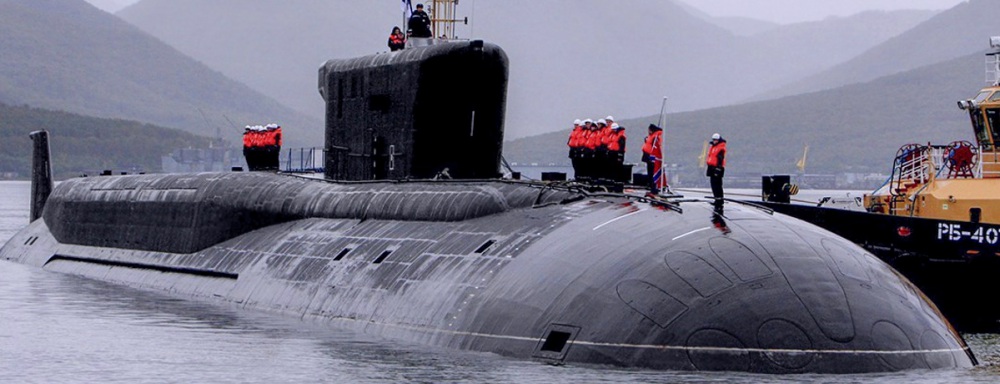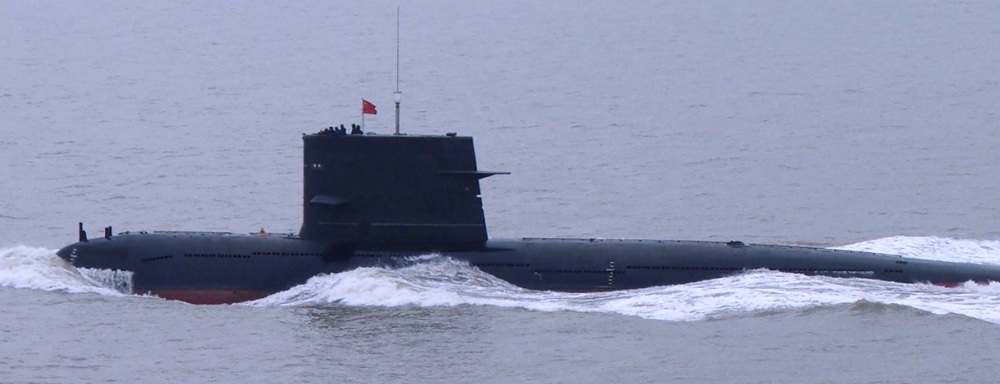
About the image
Capabilities at a Glance
The Japanese Maritime Self-Defense Force (JMSDF) currently operates two flotillas divided into five squadrons. The First and Second Submarine Flotillas are based at Kura and Yokosuka respectively. The JMSDF operates twenty-two diesel-electric attack submarines: nine Oyashio-class and twelve Sōryū-class and one Taigei-class vessels.1 Mitsubishi Heavy Industries and Kawasaki Shipbuilding Corporation constructed all three classes of submarines in Kobe, Japan.2
Total Submarines in Fleet: 20
- Ballistic Missile Submarines (SSBNs): 0
- Nuclear-Powered attack submarines (SSNs): 0
- Diesel-electric attack submarines (SSKs): 22
- Air-independent propulsion (AIP) enabled: 11/19
Submarines
History
In 1905, the Imperial Japanese Navy acquired five Holland-class vessels from the U.S. company Electric Boat.3 Soon afterwards, Japan began constructing its own submarines, and by the beginning of World War II possessed one of the world’s most powerful submarine fleets. Following its defeat in World War II, Japan dissolved the Imperial Japanese Navy. In 1954, the Japanese government passed the Self-Defence Forces Law which created the JMSDF. Since that time, Japan has actively maintained a small but capable submarine fleet, allocating resources to ensure technological superiority over its regional competitors.4
Japan began production of the Oyashio-class submarines in March 1998. From 1998 to 2008, Japan produced one submarine per year. In 2010 Japan responded to increased tensions with China surrounding the Senkaku (or Diaoyu) Islands and North Korean aggression with a plan to build an improved version of the Oyashio-class submarines.5 This new class became known as the Sōryū-class. The first vessel, JS Sōryū (SS-501), was laid down in 2005 and commissioned in 2009.6
Modernization and Current Capabilities
The 12th and final Sōryū-class submarine was commissioned in March 2021. In June 2019, Mitsubishi Heavy Industries announced its plan to create a new class of submarines, the Taigei-class attack submarine, based on the Sōryū-class vessels. There are plans for seven vessels in this class.7 The first submarine of the fleet, the JS Taigei (meaning ‘big whale’ in Japanese), was commissioned March 9, 2022, costing 690 million USD and bringing Japan’s submarine fleet to the Ministry of Defense’s 2010 goal of 22 subs.8 Most recently, the JMSDF launched the JS Hakugei in October 2021, which is expected to enter service in March 2023, and the JS Jingei in October 2022, which is expected to be commissioned in March 2024.9
The Sōryū-class JS Ōryū was Japan’s first submarine to employ lithium-ion batteries. The new Taigei-class submarines will all employ lithium-ion batteries, increasing the speed and range of the submarines due to a higher power output. The lithium-ion batteries also allow for greater underwater endurance.10
Japan’s actions to continually increase its submarine fleet can be attributed to the changing security situation in East Asia combined with decreasing U.S. desire to intervene.11
Ship Biographies
Oyashio-Class
Japan possesses nine Oyashio-class diesel-electric attack submarines. These submarines are 81.7 meters long with an 8.9-meter-wide beam and can travel up to 20 knots when submerged. The hull of these vessels incorporates a leaf coil design.12 Their weapons systems are equipped with six 533mm torpedo tubes which can accommodate Type 89 torpedoes or submarine-launched UGM-84 Harpoon missiles.13
Sōryū-Class
Japan possesses twelve Sōryū-class diesel-electric attack submarines. These submarines are 84 meters long with a 9.1-meter-wide beam and can travel up to 20 knots when submerged. They have an air-independent propulsion (AIP) system. Their weapons systems are capable of firing torpedoes and anti-ship missiles. The last two vessels in this class, the JS Ōryū and the JS Tōryū, are equipped with lithium-ion batteries as its power source.
Taigei-Class
Japan possesses three Taigei-class diesel-electric attack submarines. This submarine is 84 meters long with a 9.1-meter-wide beam. At the time of update, the speed of this class of vessels is unknown. It has a single-shaft diesel-electric propulsion system. Their weapons systems are equipped with six 533mm torpedo tubes which can accommodate torpedoes or submarine-launched missiles.14
Import and Export Behavior
Imports
Japan developed its own submarine design and production infrastructure, but imported Swedish company Kockums’ AIP system to use in its Sōryū-class vessels.15 In 2015, the U.S Department of State approved the possible sale of 48 UGM-84L Harpoon Block II submarine launched missiles to Japan. The sale, estimated at $199 million, will allow Japan to supplement its existing Harpoon missile capability.16
Exports
Japan does not currently export submarine technology. However, in light of the abolition of the self-imposed arms embargo, India and Australia have reached out to Japan for submarine procurement. In 2014, negotiations began between Japan and Australia regarding the purchase of fully engineered vessels.17 The Indian government is also considering Japan as a possible submarine supplier. Japan has been asked to “consider the possibility” of building six stealth submarines for the Indian Navy. The Japanese government has so far remained hesitant to negotiate a sale.18
Explore the Collection
Australia Submarine Capabilities
Brazil Submarine Capabilities
Chile Submarine Capabilities
China Submarine Capabilities
France Submarine Capabilities
Germany Submarine Capabilities
Greece Submarine Capabilities
India Submarine Capabilities
Indonesia Submarine Capabilities
Iran Submarine Capabilities
Israel Submarine Capabilities
Italy Submarine Capabilities
Your are currently on
Japan Submarine Capabilities
Malaysia Submarine Capabilities
Netherlands Submarine Capabilities
North Korea Submarine Capabilities
Pakistan Submarine Capabilities
Russia Submarine Capabilities
Singapore Submarine Capabilities
South Korea Submarine Capabilities
Sweden Submarine Capabilities
Taiwan Submarine Capabilities
United States Submarine Capabilities
Submarine Detection and Monitoring: Open-Source Tools and Technologies
Stay Informed
Sign up for our newsletter to get the latest on nuclear and biological threats.
More on

Russia Submarine Capabilities
Overview of Russia's submarine capabilities and import-export behavior.
United States Submarine Capabilities
Overview of the United States' submarine capabilities and import-export behavior.

China Submarine Capabilities
A highlight of global trends in the sale and acquisition of diesel- and nuclear-powered submarines by country with capabilities, imports and exports. (CNS)
Glossary
- SSBN
- Ship, Submersible, Ballistic, Nuclear: A hull classification for a submarine capable of launching a ballistic missile. The "N", or nuclear, refers to the ship's propulsion system. SSBN's are generally reserved for strategic vessels, as most submarine launched ballistic missiles carry nuclear payloads. A non-strategic vessel carries the designation SSN, or attack submarine.
- Diesel-electric submarine
- Diesel-electric submarine: A submarine with a diesel-electric transmission. Diesel-electric transmissions require access to oxygen for the diesel generator to charge the submarine’s batteries or drive the motor. This type of submarine is thus louder and must surface more frequently than a nuclear-powered submarine. A diesel-electric submarine can fire conventional cruise missiles against land targets, and in theory, can also carry nuclear-tipped cruise missiles. Diesel-electric submarines are significantly cheaper to build and purchase than nuclear-powered vessels, which makes them the vessel of choice for smaller navies.
- Air Independent Propulsion Technology (AIP)
- Air Independent Propulsion Technology (AIP): A propulsion system that uses liquid (or compressed) oxygen or hydrogen fuel cells, thereby allowing submarines to stay submerged for longer periods without the need for external sources of oxygen. This increased endurance also increases a submarine’s survivability.
Sources
- “Jane’s World Navy: Japan,” IHS Jane’s, 24 April 2014, www.janes.com.
- “Harushio-class submarine SS,” Seaforces-online Naval Information, 2013, www.seaforces.org.
- James Delgado, Silent Killers: Submarines and Underwater Warfare, (Osprey Publishing, 2011), 118.
- Steven Aftergood, “Japan Defense Agency Japan Self-Defense Force,” Federation of American Scientists, 12 October 2000, https://fas.org.
- “Japan to beef up submarines to counter Chinese Power,” The Chosun Ilbo, 26 July 2010, www.chosun.com.
- “SS-501 JS Sōryū - Blue Dragon Submarine,” Strategy & History, accessed 2 August 2019, http://remorika.com.
- Peter Suciu, “Meet Japan’s Stealthy Taigei-class of Diesel-Electric Submarines,” The National Interest, 11 January 2021, https://nationalinterest.org.
- Takahashi Kosuke, “Japan Commissions First New Taigei-Class Diesel-Electric Attack Submarine,” The Diplomat, 9 March 2022, https://thediplomat.com.
- kahashi Kosuke, “Japan Launches Third Taigei-Class Submarine for JMSDF,” The Diplomat, 12 October 2022, https://thediplomat.com.
- “Taigei-Class Attack Submarines, Japan,” Naval Technology, 8 July 2022, www.naval-technology.com.
- “Oyashio Class Submarines, Japan,” NavalTechnology.com, accessed 26 May 2014.
- “Jane’s Sentinel Security Assessment: Defense Production and R&D - Japan,” IHS Jane’s, 4 April 2014, www.janes.com.
- “Oyashio Class Submarines, Japan,” NavalTechnology.com, accessed 26 May 2014.
- “Taigei-Class Attack Submarines, Japan,” Naval Technology, 8 July 2022, www.naval-technology.com.
- “Kockums Stirling AIP System,” Kockums, accessed 26 June 2014, www.kockums.se.
- Ridzwan Rahmat, “US Approves Sale of Submarine-launched Harpoon Block II to Japan,” IHS Jane’s 360, 17 May 2015, www.janes.com.
- Tim Kelly and Matt Siegel, “Japan & Australia consider submarine deal that could rattle China,” Reuters, 28 May 2014, www.reuters.com.
- Vivek Raghuvanshi and Paul Kallender-Umezu, “Japan Unlikely to Join Indian Sub Tender,” Defense News, 11 April 2015, www.defensenews.com.
